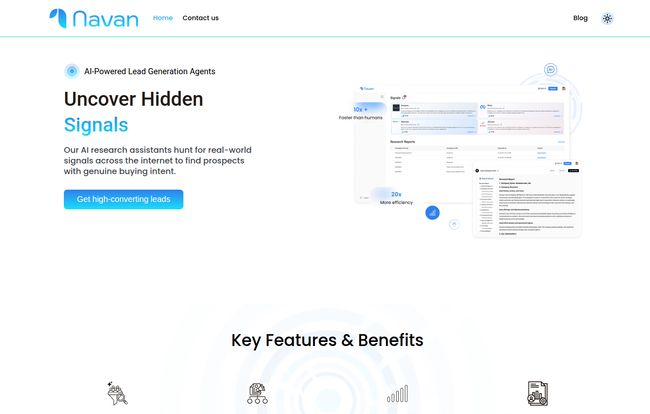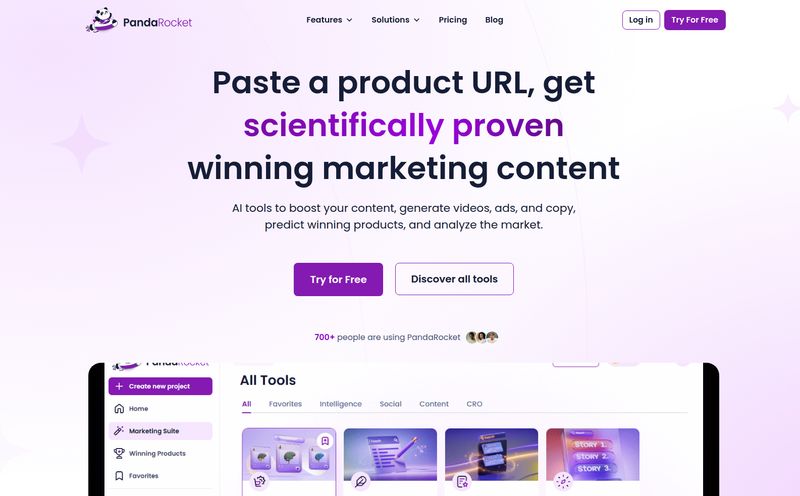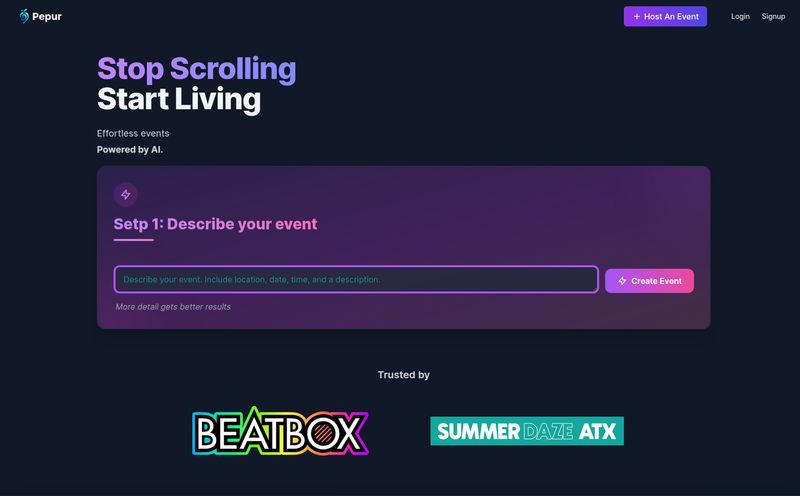If you've spent any time in sales, marketing, or business development, you know the grind. The endless hours scrolling through LinkedIn Sales Navigator, the meticulously crafted spreadsheets that become obsolete the second you save them, the sheer mind-numbing repetition of trying to find the right person at the right company at the right time.
It’s a game of needles and haystacks. And most days, it feels like we're just collecting more hay. We've all been there, sending that beautifully personalized email only to get a reply saying, “We just signed a contract with your competitor last week.” Ouch. The timing was off.
So when a tool like Navan.ai pops onto my radar, promising to use AI to “uncover hidden signals” and find prospects with genuine buying intent, my inner skeptic and my hopeful marketer have a little argument. The skeptic rolls his eyes, muttering about another overhyped SaaS platform. But the marketer... the marketer leans in a little closer. Because what if?
What Exactly is Navan.ai Supposed to Do?
On the surface, Navan.ai presents itself as an AI-powered lead generation platform. But that's a bit like calling a supercar “a way to get to the grocery store.” It misses the point. The core idea here isn’t just to give you a list of names. It’s to give you a list of names with context.
Think of it less as a list builder and more as a team of junior research assistants who work 24/7. These assistants are programmed to know your Ideal Customer Profile (ICP) inside and out. They then scan the entire internet—company news, funding announcements, press releases, hiring trends—looking for events that suggest a company is about to need what you sell. It’s a metal detector for buyer intent.
Interestingly, when I dug around a bit, I found that Navan.ai also has a whole other side to its business: a no-code platform for building computer vision AI models. That might seem irrelevant, but to me, it adds a layer of credibility. These folks aren’t just slapping an “AI” label on a simple scraper; they seem to have some serious technical chops behind the curtain.

Visit Navan.ai
The Core Features: A Look Under the Hood
So, how does this all come together? The workflow seems pretty straightforward, built around a few key functions.
AI-Powered Lead Discovery and Your ICP
Everything starts with you telling the AI what a good lead looks like. You define your Ideal Customer Profile—industry, company size, location, you know the drill. This is the brain of the whole operation. The better you define your ICP, the more relevant the signals it brings back will be. Garbage in, garbage out, as they say.
Daily Signals and Insights
This is where the magic is supposed to happen. Instead of a static database, Navan.ai delivers a daily feed of events. Did a target company just get a massive Series B funding round? They're probably looking to scale, and they’ll need new tools. Are they suddenly hiring a bunch of marketing managers? They might be gearing up for a big campaign. These are the buyng singals, the little breadcrumbs that lead to a sale. It’s all about connecting with them in that crucial window of opportunity.
Signal Strength Scoring
I love this idea. Not all signals are created equal. A company hiring one new salesperson is interesting. A company announcing a $50 million funding round and a new C-suite executive is a five-alarm fire. Navan scores these signals, allowing you to prioritize your outreach and focus on the leads that are most likely to be receptive. It’s a simple, but powerful way to manage your time effectively.
CRM Integration
Thank goodness. Any modern sales tool that doesn't integrate with a CRM is basically just creating more work. The ability to sync these hot leads and their associated insights directly into your Salesforce, HubSpot, or whatever you’re using is non-negotiable. It keeps the whole team on the same page and avoids the dreaded “data silo” problem.
That Sounds Great, But What's the Catch?
Alright, let's get down to brass tacks. No tool is perfect, and from my analysis, Navan.ai has a few things you should be aware of before you get too excited and pull out the company card.
The “Coming Soon” Features
The biggest caveat for me is that the automated outreach component is listed as “Available soon.” Right now, Navan finds the lead and the reason to reach out, but you (or your team) still have to write and send the email or LinkedIn message. This isn’t a dealbreaker, as the research is often the hardest part. But it means Navan is currently a lead intelligence tool more than a full-funnel lead generation tool. I'm very curious to see how their AI-generated outreach works when it finally drops.
Manual Research Isn't Dead Yet
The platform itself includes a step called “Conduct Manual Research.” Some might see this as a flaw. “Shouldn’t the AI do everything?” In my experience, no. The best AI tools are assistants, not replacements. The AI gets you 90% of the way there, flagging an opportunity. But that final 10%—a quick look at the contact's LinkedIn profile, a glance at the company's recent posts—is where a good salesperson adds their own human touch. I actually see this as a positive; they’re being realistic about the role of AI in a human-centric process like sales.
Let's Talk About Navan.ai Pricing
Money talks. The pricing structure is pretty clear, which I appreciate. It's tiered for different team sizes.
| Plan | Price | What You Get |
|---|---|---|
| Pro | $99 / month | 1 user, 1 query, 20 deep searches. Good for solo pros and small teams. |
| Team | $199 / month | 3 users, 5 queries, 100 deep searches. Built for growing sales and marketing teams |
| Enterprise | $999 / month | 5 users, 25 queries, 500 deep searches. For the big players. |
The Pro plan at $99 seems very reasonable for an individual consultant or a small startup trying to get traction. The jump to Enterprise at $999 is steep, but for a large sales organization, the ROI could be massive if it prevents them from wasting thousands of hours on cold leads. Is it expensive? Well, what's the cost of your sales team's time? I’ve seen companies spend more on bad PPC campaigns in a single day.
Who is Navan.ai Actually For?
I see this being a great fit for B2B companies, particularly in fast-moving sectors like tech, SaaS, finance, and professional services where company changes are frequent and public. If you're a business development rep, a small agency owner, or a sales manager tired of hearing your team complain about lead quality, this is definitely worth investigating.
Who is it not for? Probably most B2C businesses. It's also not for teams on an absolute shoestring budget or those who need a fully automated, hands-off machine right this second (given the current lack of automated outreach).
My Final Thoughts and Verdict
So, is Navan.ai the holy grail of lead generation? Not yet. But it’s one of the most interesting and promising approaches I’ve seen in a while. It’s trying to solve the right problem: not the quantity of leads, but the quality and timing of outreach.
For my money, the real value here is time and intelligence. It automates the most soul-crushing part of prospecting—the research—and empowers salespeople to do what they do best: connect with other humans and solve their problems. It’s a strong concept, and if they nail the execution of their upcoming outreach features, they could really have something special on their hands.
Frequently Asked Questions about Navan.ai
- How does Navan.ai generate its lead signals?
- It continuously scans a massive range of public data sources—news sites, financial press releases, company blogs, social media, and more. Its AI is trained to identify and interpret significant events, like funding rounds, new executive hires, product launches, or expansion plans, and then serve them up as actionable signals.
- How do I integrate Navan with my CRM?
- While the specific steps can vary depending on your CRM, integration is a core feature. It typically works through a secure API connection or a dedicated plugin. The goal is to get the lead data and the crucial “reason to reach out” directly into your team's existing workflow without any manual data entry.
- What industries is this platform best for?
- It's built for the B2B world. It excels in industries where buying indicators are public and frequent. Think technology, SaaS, financial services, marketing agencies, and even larger-scale manufacturing or logistics. It would be less effective for most direct-to-consumer businesses.
- Is Navan.ai just a fancy web scraper?
- I'd argue no. A simple scraper just pulls raw data. Navan's platform is about interpretation and intelligence. It doesn’t just tell you a news article exists; its AI analyzes the article, understands its significance, scores the opportunity, and matches it against your ideal customer profile. It’s the difference between being handed a phone book and being handed a curated list of people who are waiting for your call.
- Can it replace my sales team?
- Absolutely not. And it shouldn't. It's a tool to make your sales team more efficient and more effective. It takes the grunt work of research off their plate, so they can spend less time searching and more time selling and building relationships. It's a force multiplier, not a replacement.
Conclusion
In a world overflowing with data, the real advantage isn't having more of it; it's understanding what it means. Navan.ai is making a compelling case that it can provide that understanding. It’s a tool that respects the salesperson's time and intelligence, aiming to arm them with the right information at the right moment. It's not perfect, but it's a significant step in a very interesting direction. I, for one, will be watching them closely.
Reference and Sources
- Navan.ai Official Website: https://www.navan.ai/
- HubSpot Blog - The Ultimate Guide to Sales Triggers: https://blog.hubspot.com/sales/sales-triggers-guide



